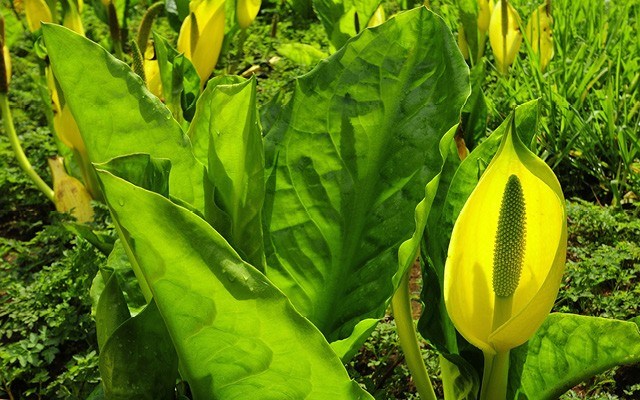Long before bears stir in their dens, before salmonberries bloom pink on woody stems and vine maples unfold their leafy fans, skunk cabbage periscopes through wetlands.
Its yellow flower is the first sign of spring. Green leaves quickly unfurl and emit a pungent skunk-like odour that is hard to miss. The uninitiated will hold their noses and exclaim, "It stinks!"
The BFF of bears and early pollinators, skunk cabbage blooms before bees are active. Because of this, it attracts its own entourage with a foul stink. The smell comes from its leaves — when bruised they release a scent that attracts flies and beetles. Mistaking the odour for a rotting animal to lay their eggs on, they seek out the flower hidden within the hood-like leaf, which is called a spathe. And when they do, they transfer pollen from male to female plants.
It's also a warm shelter to rest in, since skunk cabbage literally heats up air around it. If you were to put your finger inside the spathe at the right time and touch the flower, your fingertip would get warm. For a period of almost two weeks, the air temperature surrounding skunk cabbage can increase by up to 20 degrees. The heat skunk cabbage creates rises and helps to spread the odour, attracting more insects to this hotspot and making skunk cabbage as popular with some bugs as charging stations in airports.
Skunk cabbage is sometimes known as bearweed, as bears are one of the few animals that eat the buds and leaves.
When bears awake after hibernating, they haven't defecated in a long time. Prior to hibernation, they ingested leaves, hair, dirt and needles to form a fecal plug up to a foot long in their lower intestine. When they wake up, they need to become unplugged before they can feast on grasses and grubs.
Enter skunk cabbage, nature's Ex-Lax. Bears eat the plant to get things moving again. But don't think about trying it yourself: the juices of its leaves cause serious inflammation in the mouth.
Skunk cabbage reminds us that bears will soon be sharing our favourite trails again, so when you start to see skunk cabbage around, remember to make noise and be aware of your surroundings.
Skunk cabbage is the guest that shows up early for the party, then slips out when it is in full swing. By the time berry season hits, its 1.3-metre tall leaves will have decayed and dissolved back into the muck it came from.
In its dreadlock of roots, it stores energy for next spring, when it will rise out of the ground like something out of a B-grade horror film and win over the flies and the bears (and maybe even you) with its unforgettable scent.
The Whistler Naturalists are a non-profit volunteer group dedicated to increasing local knowledge of the natural world in the Whistler area. For more information or to get involved please visit WhistlerNaturalists.ca.
Call for volunteers — The Naturalists are looking for volunteers to help organize upcoming events and write NatureSpeak articles. For more information please contact Kristina at [email protected].




